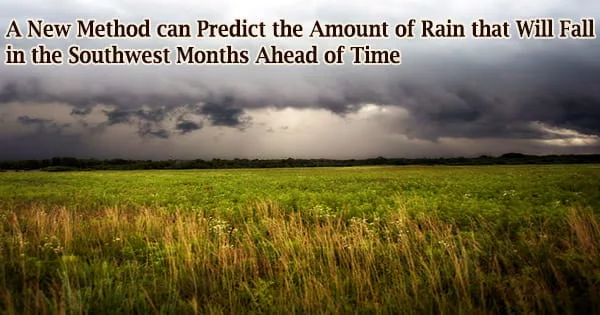As reservoir levels in the arid southwest United States decline, scientists have devised a mechanism for forecasting summer rains months ahead of time. Such seasonal forecasts can assist state and municipal officials in making important reservoir storage and water distribution choices earlier in the season, resulting in more effective water management.
Summer rains in Arizona and New Mexico are not predicted accurately by current seasonal predictions. However, a group of scientists discovered that a variable in those same projections, the amount of water vapor in the lower atmosphere, could, starting in April, predict precipitation trends across a wide part of the region between June and October, doing particularly well in Arizona. In a paper published in Geophysical Research Letters, they reported their findings.
“The method is surprisingly successful, enabling us to look at individual catchments and correctly predict months ahead of time whether they will get above or below-average rainfall,” said Andreas Prein, a scientist at the National Center for Atmospheric Research (NCAR) who led the study.
“It’s exciting because the desert Southwest is one of the most water-stressed regions in the world, and water management decisions have to be made way in advance before rainfall occurs.”
Unlike some other research discoveries, this one will be tested right away. The study’s funding source, the United States Bureau of Reclamation, will examine the prediction system this year in the Colorado River and Rio Grande basins in the Southwest.
Reclamation is responsible for managing water supplies and operating hundreds of reservoirs, and several of its hydrologists collaborated with NCAR on the project. The National Science Foundation, which funds NCAR also supported the study.
“We are optimistic that this method will lead to some breakthroughs in forecasting inflows on the lower Colorado River and improved operations in the basin,” said Shana Tighi, a hydrologist with Reclamation’s Lower Colorado Basin Region and a study co-author.
The method is surprisingly successful, enabling us to look at individual catchments and correctly predict months ahead of time whether they will get above or below-average rainfall.
Andreas Prein
“Monsoon forecasting has long been a particular challenge in the Rio Grande Basin in New Mexico, where the monsoons can provide a significant portion of the water supply but have long been considered unpredictable,” said Dagmar Llewellyn, another study co-author and supervisor of the water planning group in the Albuquerque Office of Reclamation. “This new technique has promise to allow significant improvements in water management.”
Contending with water scarcity
Water scarcity is a major issue in the Southwest of the United States. Even as temperatures rise and water needs rise as a result of a rapidly growing population, the region is experiencing one of its worst droughts in decades. The snowpack in the mountains provides much of the water in reservoirs, but it is dwindling, a trend that is predicted to continue with climate change.
Water management would aim to make greater use of rains from the North American Monsoon to assist offset the loss of snowpack. During much of the summer and early fall, southerly winds carry moisture from the Pacific Ocean, Gulf of California, and Gulf of Mexico, resulting in 60-80 percent of the annual precipitation in the desert Southwest.
However, it varies greatly from year to year, and scientists haven’t been able to determine whether the approaching monsoon season will bring an average amount of rain, or whether it will be especially wet or dry.
To investigate if they might produce months-ahead predictions of the monsoon, Prein and his co-authors looked to the long-range forecasts of many top weather models. While such forecasts are poor when it comes to predicting rain, they are more accurate when it comes to showing larger-scale atmospheric phenomena like high- and low-pressure systems.
From 1982 to 2018, the researchers used a specialized algorithm on each of the weather models to see if any of 12 atmospheric variables, such as temperature, humidity, winds, and atmospheric pressure at various heights, could be linked to monsoon rainfall variability in Arizona and New Mexico catchments. The research was done on the NCAR-Wyoming Supercomputing Center’s Cheyenne supercomputer.
They were able to identify that one of the models, which is run by the European Centre for Medium-Range Weather Forecasts and is well-known for accurate atmospheric forecasting, may be used to forecast monsoonal rainfall using this method.
When the model produced long-range estimates of low-level atmospheric moisture for the following summer months in April, the scientists were able to correctly correlate the moisture with the amount of monsoonal rain that fell during those months.
Except for southern New Mexico, the link was significant in all of the study’s catchments. Scientists are looking into why the projections in Arizona were better than in New Mexico, but it’s most likely due to the more complex atmospheric mechanisms that drive the New Mexico monsoon.
The scientists were able to construct a monthly forecast that showed how rainfall at the catchments would compare to the historical average by estimating the number of days when the lower atmosphere had a substantial amount of moisture.
“The number of moist days is highly correlated with how much rainfall you get in a catchment,” Prein said.
Prein and his colleagues are now intending to put the technology to the test in the West during the winter months. He added that the method may be used in other areas.
“The framework itself is very generalizable and can be applied to a variety of different regions and different seasons,” Prein said. “This points the way to better seasonal predictions for water resource management across the United States as well as other parts of the world.”
















